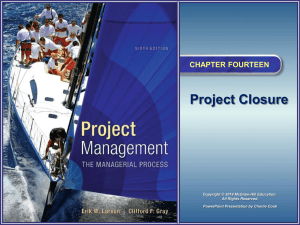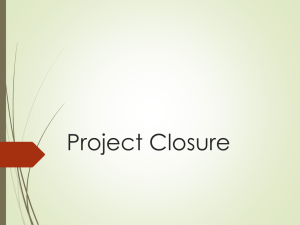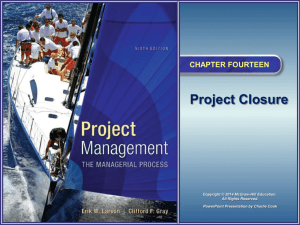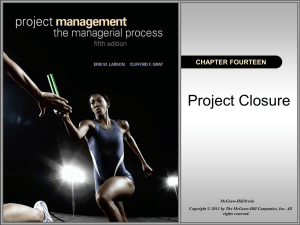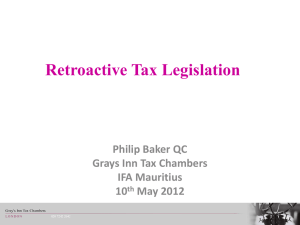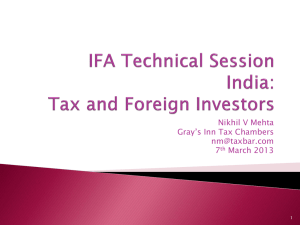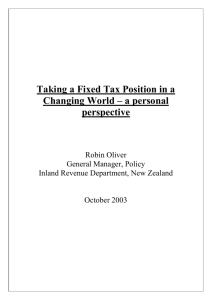number of ideas
advertisement
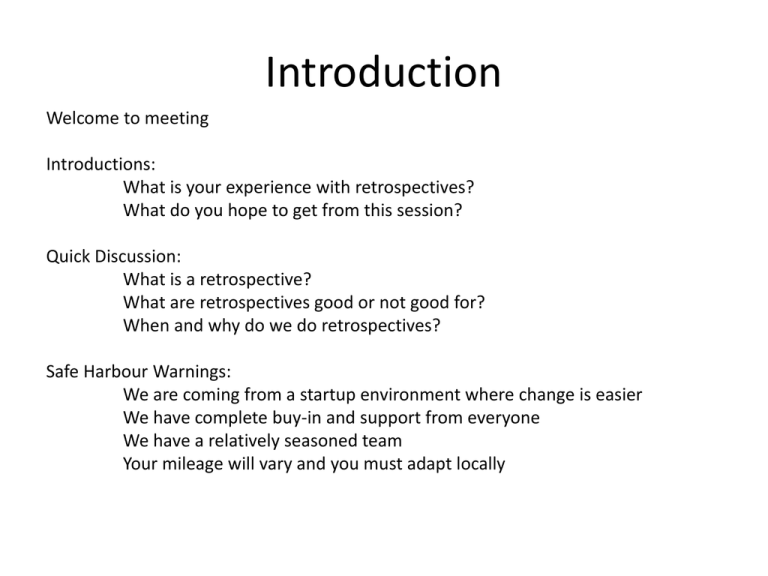
Introduction Welcome to meeting Introductions: What is your experience with retrospectives? What do you hope to get from this session? Quick Discussion: What is a retrospective? What are retrospectives good or not good for? When and why do we do retrospectives? Safe Harbour Warnings: We are coming from a startup environment where change is easier We have complete buy-in and support from everyone We have a relatively seasoned team Your mileage will vary and you must adapt locally A Framework for a Retrospective This framework is taken from Agile Retrospectives and provides enough structure to keep retrospectives on track and flowing 1) Set the Stage: getting the team ready to engage in the retrospective (5%) 2) Gather Data: create a shared picture of what happened during the retrospective period (25-40%) 3) Generate Insights: interpret and analyze the data to figure out what happened (2540%) 4) Decide What to Do: identify highest priority items to work on and put measurable goals on those items so they can be completed (10-20%) 5) Close the Retrospective: reflect on the retrospective and how to improve it, and to appreciate accomplishments of the team and individual interactions (5-10%) Set the Stage “Getting the team ready to engage in the retrospective” Welcome everyone to the retrospective and express appreciation for hard work leading to retrospective and willingness to attend -> provides respect to all attendees Provide a short amount of time for everyone to speak: to introduce themselves or to answer a simple question (“how did the sprint go?”, “what are you looking for?”) --> people are more likely to contribute when they have already talked and have been listened to Describe the approach to the session: agenda, working agreements, timeboxes -> organization respects people’s time investment -> creates a safe environment in which to have discussions Activities: - Checkin: provide opportunity for everyone to talk and listen (as above) - ESVP: Explorer / Shopper / Vacationer / Prisoner – everyone thinks about why they are there Gather Data “create a shared picture of what happened during the retrospective period” Capture data about what occurred during the period - events: new hire, important sale, decisions, milestones - metrics: burndowns, velocity, unit tests, build failures, features completed, cycle time - stories and features completed - customer stories - feelings Activities: - Timeline: work in groups to remember what happened and place items on a timeline - Mad Sad Glad: find times or events when you were mad, sad, or glad -Triple Nickels: break into groups and invidually write ideas on a topic; pass around to each team member in turn to build on ideas - Locate Strengths: pairwise interviews (not discussions!) about how the iteration or project went – be curious, ask follow questions Generate Insights “interpret and analyze the data to figure out what happened” Start asking why things happened - look at conditions, interactions, patterns - look for breakdowns, deficiencies, risks surprises - look both at bright spots of successes and dark spots of pain Dig to get to root causes; first impressions are often correct but may not be deep enough to get to the problem Activities: - Brainstorming: free-form generation of ideas with minimal or no discussion; build on previous ideas to get new ones - Five Whys: why did an event occur? Iterate on why and record the 4th or 5th iteration. - Identify Themes: generated data contain common themes; try to group them to get to the common themes Decide What to Do “identify highest priority items to work on and put measurable goals on those items so they can be completed” Insights generate potential experiments and improvements - What are the highest priority, the biggest impact, likely to succeed? Focus on a very small number of items first (maybe 1) until you establish success Create paths to success: - frame changes in the context of things you are already doing - engage both the rational and emotional side - use your Scrum tools - info radiators, removing impediments, responsibility Activities: - Dot voting: the team votes on what they think are the most important items - SMART goals: ideas that are Specific, Measurable, Achievable, Relevant, Timely - Short Subjects: Keep / Drop / Add; Start / Stop / Keep Doing; Plus / Minus / Interesting Close the Retrospective “reflect on the retrospective and how to improve it, and to appreciate accomplishments of the team and individual interactions “ Important to reach closure on retrospective - plan for documenting what occurred - plan for following up on initiatives and experiments - retrospect on the retrospective so the next one is even better - time for team to appreciate each other and celebrate successes - appreciate the time and effort everyone has put into improving their team Activities: - + / delta: what to keep and build on, what to change - Appreciations: personally notice and celebrate accomplishments of the team and its members - “thank you to Pat for helping me with …” - Return on Time Invested: quick gauge of whether people found value from 0 (no benefit for time invested) to 4 (high return on investment) Things to Watch Out For People spend too much time emphasizing the negatives and don’t take credit for the good things that happened Nobody says anything and stares at the floor One person dominates the discussion People play the blame game People don’t let others finish what they’re saying The team identifies the same issues time after time and after a while they give up because nothing ever comes of it Discussion What kinds of successes have people had with retrospectives? Are teams having problems getting started or getting momentum? How do you get the team all rowing in the same direction? What level of management support do you have? Are there differences between sprint, release, project retrospectives? How do you create the safe environment in which real discovery happens? References Lots of material and discussion everywhere, including: Agile Retrospectives, by Esther Derby and Diana Larsen - provides framework, exercises, and help on conducting retrospectives Switch: How to Change Things When Change is Hard, by Chip Heath and Dan Heath - discusses why change is hard and provides guidelines to assist - Direct the Rider, Motivate the Elephant, Shape the Path Drive: The Surprising Truth About What Motivates Us, by Daniel Pink - discusses the keys to motivation: Autonomy, Mastery, and Purpose
